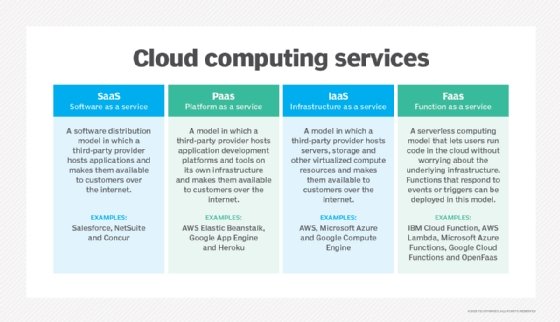
viperagp - stock.adobe.com
Words to go: Basic cloud computing terms
New to cloud computing? Use this list of basic terms to familiarize yourself with common deployment models, service categories and top providers.
While cloud computing is now a staple technology in many enterprises, some IT teams are just beginning their cloud journey.
With cloud computing, enterprises can more efficiently deploy and scale IT infrastructure resources. Users access these virtualized resources in a self-service model and spin them up on demand. If enterprises suddenly require more compute capacity, the cloud's elasticity enables them to scale up, as needed, and then down again when workload demands decrease.
Use these basic cloud computing terms to learn more about specific deployment models, available services and top providers.
Cloud deployment models
Before it migrates to the cloud, an enterprise must determine which deployment model best meets its needs. This decision is based upon numerous factors, such as security, performance requirements and cost. The four main cloud deployment models are:
Public cloud: The public cloud is a multi-tenant environment in which a third-party provider offers services and resources, such as compute and storage, to users over the internet. Enterprises pay for the cloud resources they consume on a pay-as-you-go basis.
Private cloud: A private cloud is based on a proprietary architecture that is dedicated to one organization. An enterprise typically builds and maintains its own private cloud infrastructure in-house but can also choose to use an off-premises hosted private cloud. Private clouds give enterprises more direct control over their data and IT environment, making them especially attractive to businesses with strict governance and compliance requirements.
Hybrid cloud: In this deployment model, an enterprise uses both a public and private cloud. Workloads move between the two environments, and organizations can perform cloud bursting when they need additional capacity. Hybrid cloud affords an enterprise the flexibility of the public cloud, while allowing mission-critical workloads to remain on premises, behind the company's firewall.
Multi-cloud: A multi-cloud strategy generally refers to the use of multiple public clouds from different providers. Enterprises can use this model to minimize vendor lock-in risks and select the best cloud services for their workloads, based on cost, feature set and other factors. Multi-cloud deployments also increase redundancy and ensure high availability.
Cloud service categories
Cloud computing can be broken out into three core categories, each of which delivers a different set of resources as a service. To choose between these three categories, enterprises need to decide how much responsibility they want over their infrastructure. Review these additional cloud computing terms to decide which category is best for you:
Software as a service (SaaS): With SaaS, the cloud provider hosts applications on its own infrastructure and makes those applications available to users over the internet. The provider manages all the underlying resources that support an application, ranging from servers and networks to middleware and OSes. Of all three cloud computing service categories, SaaS requires the least management from the user.
Platform as a service (PaaS): With PaaS, the cloud provider hosts resources and tools for application development on its infrastructure and makes those resources available to users over the internet. In addition to the underlying compute and storage infrastructure, a PaaS offering includes tools for text editing, version management and other tasks that enable developers to roll out software more quickly.
Infrastructure as a service (IaaS): In the IaaS model, a cloud customer uses the internet to access and use a provider's infrastructure components, such as servers, storage and networking, rather than deploy and maintain that infrastructure in-house. This service comes with the most flexibility but also the most user responsibility out of the three categories.

Major cloud providers
After you master the basic cloud computing terms above and choose the deployment model that best suits your needs, it's time to choose a cloud provider. This decision is often based on price, location, available services, security and compliance.
While most major providers have comparable services, their specific abilities and features differ. Leading private cloud vendors or platforms include VMware and OpenStack, and top public cloud providers include:
Amazon Web Services (AWS): AWS entered the market in 2006 and is currently the leading public cloud provider for IaaS, with SaaS and PaaS options as well. Its most popular services include Elastic Compute Cloud, Simple Storage Service and DynamoDB.
Microsoft Azure: In 2008, Microsoftunveiled its Azure public cloud, which also provides offerings for IaaS, PaaS and SaaS. Its popular services include Azure Virtual Machines and Azure App Service.
Google Cloud Platform (GCP): GCP consists of various public cloud services, such as Cloud Engine, its IaaS offering , and App Engine, its PaaS offering. App Engine was the first Google cloud service to launch in 2008.





